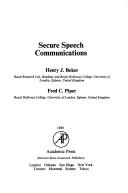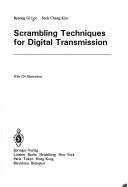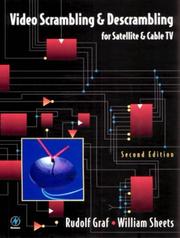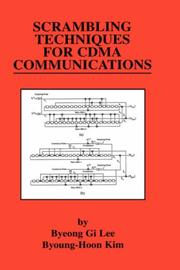| Listing 1 - 6 of 6 |
Sort by
|

ISBN: 0120847809 Year: 1985 Publisher: London Academic press
Abstract | Keywords | Export | Availability | Bookmark
 Loading...
Loading...Choose an application
- Reference Manager
- EndNote
- RefWorks (Direct export to RefWorks)

ISBN: 0387198636 3540198636 1447132335 1447132319 Year: 1994 Publisher: London,New York : Springer-Verlag,
Abstract | Keywords | Export | Availability | Bookmark
 Loading...
Loading...Choose an application
- Reference Manager
- EndNote
- RefWorks (Direct export to RefWorks)

Abstract | Keywords | Export | Availability | Bookmark
 Loading...
Loading...Choose an application
- Reference Manager
- EndNote
- RefWorks (Direct export to RefWorks)
Cable television --- Direct broadcast satellite television --- Scrambling systems.

ISBN: 1873556225 Year: 1996 Publisher: Waterford, Ireland : Waterford University Press,
Abstract | Keywords | Export | Availability | Bookmark
 Loading...
Loading...Choose an application
- Reference Manager
- EndNote
- RefWorks (Direct export to RefWorks)

ISBN: 1280208031 9786610208036 0306473216 0792374266 Year: 2002 Publisher: New York, New York : Kluwer Academic Publishers,
Abstract | Keywords | Export | Availability | Bookmark
 Loading...
Loading...Choose an application
- Reference Manager
- EndNote
- RefWorks (Direct export to RefWorks)
Scrambling Techniques for CDMA Communications addresses spreading, scrambling, and synchronization techniques for use in inter-cell synchronous and asynchronous CDMA systems, including the IMT-2000. It provides fundamental background material for sequences and shift register generators, and demonstrates various acquisition techniques in primitive, advanced levels, and in the third generation (3G) DS/CDMA cellular systems. In addition, it introduces the novel acquisition techniques DSA (Distributed Sample Acquisition) and CDMA (Correlation-aided DSA) that enable rapid and robust acquisition of inter-cell synchronous and asynchronous IMT-2000 CDMA systems. Scrambling Techniques for CDMA Communications will be invaluable to wireless communication engineers, and in particular those involved in theoretical and design works related to spreading, scrambling, and synchronization of CDMA communication systems.
Telecommunication systems --- Scrambling systems (Telecommunication) --- Code division multiple access. --- Security measures. --- Computer engineering. --- Electrical Engineering. --- Electrical engineering. --- Electric engineering --- Engineering --- Communication systems --- Communications systems --- Systems, Communication --- Electronic systems --- Telecommunication
Book
ISBN: 9783110347579 3110347571 3110347717 3110380390 9783110347715 Year: 2014 Volume: 77 Publisher: Berlin : Akademie Verlag Ein Unternehmen der De Gruyter,
Abstract | Keywords | Export | Availability | Bookmark
 Loading...
Loading...Choose an application
- Reference Manager
- EndNote
- RefWorks (Direct export to RefWorks)
Analysen der Wortstellung des Deutschen betrachten oft die Informationsstruktur als genuin syntaktischen Faktor: Funktionale Projektionen (Topik- oder Antifokusphrasen) oder ähnliche grammatische Annahmen sollen erklären, warum sich bestimmte Satzbestandteile in bestimmten Kontexten auf verschiedene Art und Weise anordnen. Die Zirkularität einer solchen Erklärung wurde dabei lange Zeit ebenso ignoriert wie ihre empirischen Probleme.Rigide Vorhersagen der Wortstellung aus Diskursfaktoren sind für das Deutsche, wie dieses Buch zeigt, empirisch nicht haltbar. Es lässt sich im Gegenteil zeigen, dass es prosodische, semantische und in Teilen auch formal-syntaktische Faktoren sind, die die Wortstellung des Deutschen empirisch korrekt und konzeptuell attraktiv zu beschreiben gestatten.Eine syntaktische Repräsentation der Informationsstruktur wird daher – entgegen einer jahrzehntelangen Forschungstradition – in der vorliegenden Analyse abgelehnt. An ihrer Stelle wird eine komplexe Grammatikarchitektur entworfen, die die syntaktischen, semantischen und prosodischen Faktoren der deutschen Wortstellung kohärent darstellt und auf neuartige Weise zueinander in Beziehung setzt.
German language --- Human information processing --- Syntax --- 803.0-56 --- Duits: syntaxis; semantiek --- Human information processing. --- Syntax. --- 803.0-56 Duits: syntaxis; semantiek --- Allemand (langue) --- Syntaxe. --- Sémantique. --- Prosodie (linguistique) --- German language - Syntax --- Information processing, Human --- Bionics --- Information theory in psychology --- Perception --- Scrambling. --- Word Order.
| Listing 1 - 6 of 6 |
Sort by
|

 Search
Search Feedback
Feedback About UniCat
About UniCat  Help
Help News
News